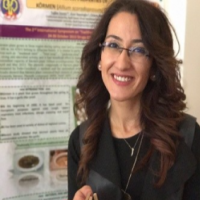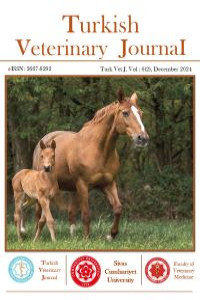Research Article
Review
Aim & Scope
Turkish Veterinary Journal (Turk Vet J), aims to publish articles (original research article, short communication, letters to editor, review article, and case report) on Veterinary basic sciences, clinic or preclinical sciences, zootechnics, animal nutrition, food hygiene and technology both in Turkish or English.
Turkish Veterinary Journal (Turk Vet J) is an international, double-blind peer reviewing scientific journal that publishes by Sivas Cumhuriyet University, Faculty of Veterinary Medicine. Manuscript will be publish should not published before in elsewhere and should be based on the research (except review articles). Turk Vet J is published twice in a year and an open access scientific journal. Special issues may be publishes by the decision of the journal administration. The journal accepts English or Turkish manuscripts. Turk Vet J doesn't asks fee for the processing the article.
Author Guidelines
Turkish Veterinary Journal
About the journal
The Turkish Veterinary Journal (Turk Vet J) is an international peer-reviewed scientific journal published by Faculty of Veterinary Medicine, Sivas Cumhuriyet University, Turkey. The Turkish Veterinary Journal (Turk Vet J) accepts manuscripts (research article, short communication, letter to editor, review article and case reports) in the field of basic sciences, preclinical, clinical, zootechnical, animal nutrition, food hygiene and technologies in English or Turkish languages.
Manuscript may be submitted in the fields of animal sciences if they contain new information of national or international interest and application. Sub-mission of a manuscript implies that it is based on research not previously published. All authors must be aware of and agree to the data presented and conclusions drawn in a manuscript.
ALL SUBMISSIONS SHOULD INCLUDE FOLLOWING DOCUMENTS
MANUSCRIPT SUBMISSION OVERVIEW
Manuscript Categories And Requirements
Turkish Veterinary Journal publishes a number of different article types including:
Original Articles – 5,000 words, including figures, tables and references
Review Articles – 5,000 words, including maximum three figures, tables and references.
Short Communications and Case reports– 1,800 words including figures, tables and references.
Any authors who are concerned that their manuscripts may exceed the recommended page limits should contact the Editorial Office prior to submission to discuss options. These will be assessed on a case-by-case basis in consultation with the author and the Editor, and the Editor’s decision will be final.
Preparing Your Submission
Main text
Manuscripts should be uploaded as a single document (containing the main text, tables, and figures). All manuscripts should be double spaced with a font size of 12 points or larger.Please ensure to have page numbers for all pages in the word document of the manuscript and make sure that all lines of your manuscript are numbered sequentially. Indent the first line of a new paragraph by hitting the tab key.
The main manuscript file can be submitted in Microsoft Word (.doc or.docx) format< br/>. Your main document file should include:
• A short informative title containing the major key words. The title should not contain abbreviations
• Abstract with Keywords
• Introduction
• Material and Methods
• Results and Discussion
• Conclusion
• References
• Tables
• Figures
Abstract
Since an abstract is often presented separately from the article, it must be able to stand alone. For this reason, references should generally be avoided, but if essential, they must be cited in full, without reference to the reference list. Also, non-standard or uncommon abbreviations should be avoided, but if their use is essential, they must be defined at their first mention in the abstract itself. Abstracts must be limited to a single paragraph with no more than 2,500 keystrokes (characters plus spaces).
Immediately after the abstract, provide a maximum of 6 keywords. Be sparing with abbreviations: only abbreviations firmly established in the field may be eligible.
Introduction
State the objectives of the work and provide an adequate background, avoiding a detailed literature survey or a summary of the results.
Material and Methods
Provide sufficient details to allow the work to be reproduced by an independent researcher. Methods that are already published should be summarized and indicated by a reference. If quoting directly from a previously published method, use quotation marks and also cite the source. Any modifications to existing methods should also be described.
Results and Discussion
Results should be clear and concise. Discussion should explore the significance of the results of the work, not repeat them. Avoid extensive citations and discussion of published literature.
Conclusion
The main conclusions of the study may be presented in a short Conclusions section, which may stand alone or form a subsection of a Discussion or Results and Discussion section.
Reference Style
This journal uses American Psychological Association (APA 7) 7 reference style.
Both the author and the date, separated by a comma, appear in parentheses for a parenthetical citation. When citing multiple works parenthetically, place the citations in alphabetical
order, separating them with semicolons. Arrange two or more works by the same authors by year of publication. Place citations with no date first, followed by works with dates in chronological order; in-press citations appear last. Give the authors’ surnames once; for each subsequent work, give only the date.
Examples
One author
(Yalçın, 2021), (Türk, 2020)
Two authors
(Coşkun & Başbuğ, 2019), (Uslu & Narlıçay, 2022)
Three or more authors
(Takcı et al., 2020), (Şen et al., 2018)
Citing Multiple Works
(Adams et al., 2019; Shumway & Shulman, 2015; Yurdakul, 2017)
Citing two or more works by the same authors
(Takcı & Kıvrak, 2022a, 2022b, 2023), (Carraway et al., 2013, 2014, 2019)
Examples
Journal Article
Kivrak, M. B., Turk, S., Takci, A., Bolukbas, B., Agaoglu, R. T., & Coskun, A. (2023). Pulse wave Doppler ultrasound of umbilical cord in experimentally induced pregnancy toxemia in sheep. Research in Veterinary Science, 160(May), 18–25. https://doi.org/10.1016/j.rvsc.2023.05.004
Lachner, A., Backfisch, I., Hoogerheide, V., van Gog, T., & Renkl, A. (2020). Timing matters! Explaining between study phases enhances students’ learning. Journal of Educational Psychology, 112(4), 841–853. https://doi.org/10.1037/edu0000396
Online Magazine Article
Gander, K. (2020, April 29). COVID-19 vaccine being developed in Australia raises antibodies to neutralize virus in pre-clinical tests. Newsweek. https://www.newsweek.com/australia-covid-19-vaccine-neutralize-virus-1500849
Authored Book
Kaufman, K. A., Glass, C. R., & Pineau, T. R. (2018). Mindful sport performance enhancement: Mental training for athletes and coaches. American Psychological Association. https://doi.org/10.1037/0000048-000
Edited Book Chapter
Zeleke, W. A., Hughes, T. L., & Drozda, N. (2020). Home–school collaboration to promote mind–body health. In C. Maykel & M. A. Bray (Eds.), Promoting mind–body health in schools: Interventions for mental health professionals (pp. 11–26). American Psychological Association. https://doi.org/10.1037/0000157-002
Dissertation From a Database
Horvath-Plyman, M. (2018). Social media and the college student journey: An examination of how social media use impacts social capital and affects college choice, access, and transition (Publication No. 10937367) [Doctoral dissertation, New York University]. ProQuest Dissertations and Theses Global.
General Style Points
Abbreviations: In general, terms should not be abbreviated unless they are used repeatedly, and the abbreviation is helpful to the reader. Initially use the word in full, followed by the abbreviation in parentheses. Thereafter use the abbreviation only.
Units of measurement: Generally, units must be abbreviated according to the International System of Units (SI units). Below you find examples of abbreviations of the most commonly used SI units:
Meter: m, Kilogram: kg, Second: s, Minute: min, Ampere: A, square meter: m2, cubic meter: m3, Hertz: Hz
Trade Names: Chemical substances should be referred to by the generic name only. Trade names should not be used. Drugs should be referred to by their generic names. If proprietary drugs have been used in the study, refer to these by their generic name, mentioning the proprietary name, and the name and location of the manufacturer, in parentheses.
Tables and FiguresEthics
A statement indicating that the protocol and procedures employed were ethically reviewed and approved, and the name of the body giving approval, must be included in the Methods section of the manuscript.
In presenting data, authors should anticipate the limitations set by the size and layout of the journal. Large and complex tables, figures and maps should be avoided in the main paper, but can be included in a data appendix for use by reviewers.
Figures should be saved in a neutral data format such as JPEG, TIFF or EPS. PowerPoint and Word graphics are unsuitable for reproduction. Please do not use any pixel-oriented programmes. Scanned figures (in JPEG and TIFF formats) should have a resolution of 300 dpi (halftone) or 600 to 1200 dpi (line drawings) in relation to the reproduction size.
Any tables and figures that are included in the main text of the paper should be numbered separately, in the sequence that they are mentioned in the text.
Each table and figure should be presented on a separate page of the manuscript, with a brief and self-explanatory title. All text should be clearly legible, and all graphics and legends should be easily distinguished when printed in black and white. Tables should use horizontal lines only, with only blank space to separate columns.
Notes under each table and figure should be used to explain and specify the source of all data shown.
Further considerations
• Manuscript has been 'spell checked' and 'grammar checked'
• All references mentioned in the Reference List are cited in the text, and vice versa
• Permission has been obtained for use of copyrighted material from other sources (including the Internet)
• Journal policies detailed in this guide have been reviewed
Title Page
Title page includes the paper title, author names, author affiliation(s), authors note. Authors note includes ORCID numbers, e-mail address of all authors, conflict of interest statement, acknowledgements and author contrubutions.
Corresponding author.
Clearly indicate who will handle correspondence at all stages of refereeing and publication, also post-publication. This responsibility includes answering any future queries about Methodology and Materials. Ensure that the e-mail address is given and that contact details are kept up to date by the corresponding author.
Conflict of interest statement
All authors must disclose any financial and personal relationships with other people or organizations that could inappropriately influence (bias) their work. Examples of potential competing interests include employment, consultancies, stock ownership, honoraria, paid expert testimony, patent applications/registrations, and grants or other funding. Authors must disclose any interests in two places: 1. A summary declaration of interest statement in the title page file (if double anonymized) or the manuscript file (if single anonymized). If there are no interests to declare then please state this: 'Declarations of interest: none' or The 'authors have no relevant financial or non-financial interests to disclose'.
Contact:
Sivas Cumhuriyet University, Faculty of Veterinary Medicine, 58140, Sivas, TURKEY
Phone: +90 346 219 18 12
Fax: +90 346 219 18 12
E-mail: turkvetj@cumhuriyet.edu.tr
Web: http//dergipark.org.tr/turkvetj
Editor in Chief
Asst. Prof. Mehmet Buğra KIVRAK
mbkivrak@cumhuriyet.edu.tr
Ethical Principles and Publication Policy
Publication processes of Turkish Veterinary Journal are based on producing, developing and sharing knowledge evenhandedly within scientific methods.
Refereed articles are studies require scientific methods and they provide objectivity. All components of publication process (publisher, editors, authors, reviewers and readers) should obey ethical rules for scientific production. Within this context, the policies of ‘publication ethics’ and ‘open access’ also require all components of publication process to obey the ethical principles, in direction of guides and policies of Committee on Publication Ethics (COPE), as “Code of Conduct and Best Practice Guidelines for Journal Editors” and “COPE Best Practice Guidelines for Journal Editors”.
In case we identify that author(s) of the manuscript use(s) falsified and fabricated data, then we will report this to the institution of the authors where he/she works and reject the manuscript. Editorial members of the journal and/or the reviewers reserve the right to ask author(s) to provide raw data which was used in the manuscript.
Ethical Responsibilities of the Publisher
Sivas Cumhuriyet University, the publisher of Turkish Veterinary Journal, is a public-spirited and nonprofit-making public educational institution.
Turkish Veterinary Journal Administrative Committee constitutes Editorial Board of Turkish Veterinary Journal. According the subject of the study, the editor can send an article to some other instructors out of Editorial Board as field editors.
The Responsibilities of Editorial Board of Turkish Veterinary Journal
• Editorial Board of Turkish Veterinary Journal is responsible for all processes of the articles sent to the journal. This responsibility requires deciding independently by considering public interest, not personal gains. The relationship between Publisher and the Editorial Board is based on independence policy, and all decisions of the editors are independent from the publisher and the other persons and institutions.
• Editorial Board of Turkish Veterinary Journal permanently strives to develop and raise the quality of the journal.
• Editorial Board of Turkish Veterinary Journal determines and performs journal policies as publication, blind review, evaluation process and ethical principles.
• Editorial Board of Turkish Veterinary Journal keeps copyrights of the articles published in The Journal of the Institute of Health Sciences of Cumhuriyet University.
• Editorial Board of Turkish Veterinary Journal is responsible for keeping intellectual property rights of authors in publication processes and guarding against unethical behaviors, plagiarism and reference gangs.
• Editorial Board of Turkish Veterinary Journal prepares a “Guide for Authors” to inform authors and “Guide for Reviewers” to inform reviewers about evaluation processes.
• Editorial Board of Turkish Veterinary Journal determines incentive policies for the authors.
• Editorial Board of Turkish Veterinary Journal her keeps records of every article electronically or in written forms.
The Responsibilities of Editors, Editor Assistants and Field Editors
• Editors try to inform reviewers, authors, researchers and readers, to answer their questions clearly within the principles of clarity.
• Editors, during the publication process, consider that the articles should be original and contribute the literature, the readers and researchers.
• While editors are making decisions about the article publication, they consider originality, contribution to the field, clarity of expressions, content and validity and reliability of the articles.
• Editors take the articles without any problem to the preliminary evaluation, consider positive views of reviewers, and they do not change the decisions of the reviewers unless there is a big problem for publishing.
• Editors implement the policies of blind review and evaluation processes, keep private personal identity information of the authors, and provide impartial evaluation processes in due of time for the articles.
• Editors send the articles to field editors and reviewers considering their professional fields, and care that the articles are evaluated impartially and independently.
• Editors, in evaluation processes, consider if there are conflicts or collaborations between authors and reviewers or not.
• Editors generate a large number or reviewers, and they update it consistently.
• Editors prevent non-scientific that do not comply with academic etiquette rules.
• Editors ensure that journal publishing processes are operated in accordance with publishing policies and guidelines, inform those who are in the process of the developments on publishing policies, and prepare training programs when necessary.
• Editors communicate effectively with everyone involved in the publishing processes, and organize meetings at regular intervals.
• Editors provide protection of personal data in assessed articles; they keep personal data of authors, referees and readers.
• Editors attach importance to the protection of human and animal rights in the articles, emphasize that the clear approval of the participants of the article is documented, and rejects the articles witout the approval of the ethics committee on the participants of the article and without any permit in experimental investigations.
• Editors take precautions against misconduct. When there are complaints about the abuse of duty, they share the findings about the subject by conducting an objective investigation.
• Editors provide errors, inconsistencies, or misleading errors in articles to be corrected.
• Editors protect the intellectual property rights of the published articles, and defend the rights of the journal and the author (s) in case of violation. Editors also take the necessary precautions to ensure that the content of the published articles does not infringe the intellectual property rights of other publications; they control authenticity-similarity.
• Editors considers consistent critiques for the articles published in the journal and enables authors to answer these critiques.
• Editors considers the studies including negative conclusions also.
• Editors evaluate the complaints sent to the journal and make necessary statements.
Ethical Responsibilities of Reviewers
The articles in Turkish Veterinary Journal are evaluated by double-blind review in a process, which neither the authors know the reviewers nor the reviewers know the authors; reviewers cannot communicate the authors directly; article evaluation forms and proofreading requests are sent to the authors through the website of the journal. Reviewers must bear the ethical responsibilities in Turkish Veterinary Journals below:
• Reviewers should only accept to evaluate the articles related to the field of their specializations.
• Reviewers should make the evaluation impartially and confidentially. In accordance with this principle, the articles they review should be annihilated after the evaluation process, but they should be used after publication. Nationality, gender, religious beliefs, political beliefs and commercial concerns should not distort the impartiality of the evaluation.
• When reviewers understand that there is a conflict or collaboration, they should inform the editors and refuse to evaluate the article.
• Reviewers must evaluate articles with a constructive attitude in accordance with the academic etiquette rules; they should refrain from insulting and hostile personal comments.
• Reviewers should evaluate the articles they agree on during the evaluation.
Ethical Responsibilities of the Authors
The ethical responsibilities of the authors that apply to Turkish Veterinary Journal as below:
• The authors should not send an article published in or sent to be published in another journal to Turkish Veterinary Journal at the same time.
• The authors should send original articles to Turkish Veterinary Journal. Authors should refer to the sources they use in writing articles in the correct way in the direction of ethical principles.
• Persons who do not contribute to the articles should not be listed as authors, and it should not be proposed to change the author order of a published article and to add authors.
• Reviewers must notify the editors of the conflicts and collaborations about the article.
• In the evaluation process of the articles the authors should provide the editorial staff with information about the articles or the raw data if required.
• The authors must document the rights to use the data they use in their articles, the permission for research or the approval of the participants to whom they have searched.
• Authors should communicate with the editors to provide information, to correct the article or to withdraw it when they are aware of the error associated with the evaluation and early appearance phase or the published article in electronic form.
• The author(s) must specify that they received the ethics committee approval for the researches that require data collection by using quantitative or qualitative methods such as experiment, survey, scale, interview, observation, focus group work that require ethics committee decision; the author(s) must also specify the name of the ethics committee, the date and the number of the ethics committee decision on the first-last page and in the method section of the candidate article. In addition, the author(s) must include information on the fact that the informed consent form was received for the case reports in the articles.
• The author(s) should present proof of their ethical principles for data collection process (such as obtaining permission from others to use their documents such as scale, questionnaire, photograph etc.) in the article. It should be noted in the articles that the copyright regulations for research and publication ethics and intellectual and artistic works are complied with. If the study is conducted on human and animal subjects, it should be reported in the article that the study was carried out in accordance with international reports, guidelines, etc.
• Ethics committee approval is not required for review articles from the author(s). However, it should be stated in articles not requiring an ethics committee decision that the ethics committee decision is not required on the first-last page and in the method section of the article.
Notification of Ethics Non-Principles Status Editor
In case of encountering an unethical situation in articles or about editors, reviewers and authors or in articles that does not comply with the ethical principles regarding in the Turkish Veterinary Journal, it should be reported by turkvetj@cumhuriyet.edu.tr
Cumhuriyet University © ContactULAKBİM Dergi Sistemleri
Price Policy
There is no article submission or publication charges. All articles published in the Turkish Veterinary Journal will be immediately and permanently free for everyone to read and download.
Indexes
Other Indexes
Journal Boards
Editor in Chief

Editorial Board




Advisory Board


 Web
Web

I obtained my PhD in Pharmacology and Toxicology from University of Plymouth (UK, 2012). On my first Postdoc, performed on the same research facilities for a period of 1 year, I organized and supervised projects of 5 PhD students based on original findings developed through my PhD proving my independent thinking and organizational and supervision skills from very early on my career. In 2013, I moved to Kirkuk University (IRAQ) to further develop my career with a Research Center in Pharmacology and Toxicology Field. There, I specialized on the Pharmacology and Toxicology (2000-2025).
My formation was complemented from the clinical side in the context of Toxicology as I interacted on a daily basis with Prof Caleb Kudi, head of the WHO headquarters leadership team (Plymouth in COTD), acquiring therefore an integral translational background in the study of COTD which revealed me as a precious asset for any translational COTD unit over UK. 2018 I decided to incorporate as the Head of the Department of Pharmacology and Toxicology from the College of Pharmacy.
My main research line was focused on the study of the human and animal changes on its properties were related with Toxicological progression as the altered function of the pesticides is key in toxicant. There, I managed to develop a brand new Research Laboratory from scratch which allowed me to publish several original research manuscripts on the topic. I am currently the leader of the International Association of Veterinary Editors.
The quality of my organization and project management skills are proven by my capacity to establish and maintain an active network which allowed me to publish original research articles in two different laboratories, in two different universities, where I have worked (UK 2007/2012; and IRAQ since 2013), showing my ability to be flexible and well organized in my approaches to research. To date, I have over 100 published peer-reviewed SCI publications (h-index 11, according to Scopus; h-index 14 according to Google Scholar), 2 book chapters, and 10 non-indexed publications. I have been awarded twice as best communication in a conference and performed 11 invited talks (USA, UK, Thailand and IRAQ). I am reviewer of 11 and editor of 3 indexed peer-reviewed journals, member of 8 scientific societies, have reviewed projects for several national and international organizations and have been internal reviewer/examiner of 35 PhD and MSc dissertations. Where I am currently supervising the work of 2 PhD students and a research technician. I have been awarded Diplomate of the European College of Veterinary Pharmacology and Toxicology since 2013,
Finally. I am also involved in public engagement activities being scientific advisor of several toxicological associations (including oximes and several IRAQI societies), having written 8 lay articles in non-scientific journals, performed lay format lectures, and being the coordinator of a science divulgation blog where I also provide original posts and having published lay articles in several media.
Professor Dr. Kasim Sakran Abass
Department of Pharmacology and Toxicology
College of Veterinary Medicine
University of Kirkuk
IRAQ
kasim_abass@uokirkuk.edu.iq

A researcher with a strong background in virology, holding a PhD in Biomedical and Life Sciences. My research focuses on zoonotic viral diseases, with specific interest in studying virus-host interactions, viral immune evasion mechanisms, and viral replication, aiming to develop targeted viral vaccines. I possess advanced technical expertise in molecular biology, computational protein design, and vaccine formulation, enabling me to contribute effectively to efforts in pandemic preparedness against viral diseases.
Secretary

Veteriner iç hastalıklarında dr.






